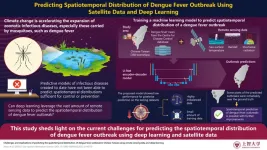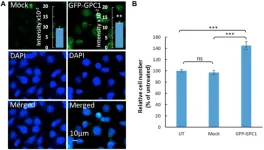(Press-News.org) Researchers at Nagoya University in Japan have identified two enzymes that are involved in macrophage polarization, one of the key factors affecting fibrosis. The group’s findings, reported in Cell Death & Disease, suggest a potential treatment for human patients.
Kidney fibrosis is a dangerous inflammatory disease that causes the organs to stiffen and lose normal function. The disease is linked to a process called macrophage polarization. Polarization is the process by which macrophages, the white blood cells that help the body fight infection and repair tissue, are changed into two types as a response to changes in the microenvironment of the cell: the M1 type, which causes inflammation, and the M2 type, which has anti-inflammatory and tissue repair properties.
Because macrophage polarization is tightly controlled and involves multiple signaling pathways and regulatory networks, imbalances in this process are common in many inflammatory diseases. In patients with kidney fibrosis, there is an imbalance between M1 and M2 macrophages. In this situation, M2 macrophages, which normally suppress inflammation, proliferate excessively and secrete factors that promote fibrosis.
Although these imbalances may be therapeutic targets, this is hampered by the fact that the mechanism of macrophage polarization involved in kidney fibrosis is still poorly understood. Furthermore, the molecular mechanisms of macrophage polarization have little in common between mice and humans, making it difficult to translate research results obtained in mice to human diseases.
A Nagoya University research group led by Assistant Professor Hideki Tatsukawa, graduate student Yoshiki Shinoda, and Professor Hitomi Kiyotaka of the Graduate School of Pharmaceutical Sciences, in collaboration with Professor Takayoshi Suganami and Lecturer Miyako Tanaka of the Research Institute of Environmental Medicine, has identified an enzyme associated with kidney fibrosis in both mice and human models called protein cross-linking enzyme transglutaminase (TG2). Their discovery opens the possibility of translating findings in mouse models into therapies for human patients.
As its name suggests, TG2 is involved in the cross-linking of amino acid residues in proteins. In fibrosis models, TG2 induces another enzyme, arachidonic acid oxidase (ALOX15), through the cross-linking process. Since previous studies have reported that ALOX15 is involved in M2 macrophage induction, the group's findings suggest that TG2 activity exacerbates kidney fibrosis by polarizing M2 macrophages using ALOX15.
“Macrophage polarization, which promotes fibrosis through cross-linking enzymes, has a similar induction mechanism in both humans and mice,” Tatsukawa said. “By targeting the regulation of macrophage function, we hope to develop treatments for various diseases caused by an imbalance between the promotion and suppression of inflammation, such as fibrosis, cancer, and atherosclerosis.”
Their research also suggests that drugs developed for celiac disease, that inhibit TG2, could be repurposed to treat fibrosis. “TG2 also converts wheat gluten into gliadin, which is known to cause gluten sensitivity (celiac disease),” Tatsukawa said. “A TG2 inhibitor has been developed for the treatment of this celiac disease and is currently in clinical trials. We believe that this inhibitor could be used in the treatment of fibrosis because researchers, including our group, have found that the administration of TG2 inhibitors suppresses the pathogenesis of fibrosis models in the kidney, liver, and lung.”
END
Enzyme-regulating macrophages found in both humans and mice open the door to translating findings in mice into human therapies.
2023-03-23
ELSE PRESS RELEASES FROM THIS DATE:
Can artificial intelligence predict spatiotemporal distribution of dengue fever outbreaks with remote sensing data? New study finds answers
2023-03-23
Outbreaks of zoonotic diseases, which are those transmitted from animals to humans, are globally on the rise owing to climate change. In particular, the spread of diseases transmitted by mosquitoes is very sensitive to climate change, and Chinese Taiwan has seen a worrisome increase in the number of cases of dengue fever in recent years.
Like for most known diseases, the popular saying “an ounce of prevention is worth a pound of cure” also rings true for dengue fever. Since there is still no safe and effective vaccine for all on a global scale, dengue fever prevention efforts rely on limiting places where mosquitoes can lay their eggs and giving people an early warning when ...
New in-home AI tool monitors the health of elderly residents
2023-03-23
Engineers are harnessing artificial intelligence (AI) and wireless technology to unobtrusively monitor elderly people in their living spaces and provide early detection of emerging health problems.
The new system, built by researchers at the University of Waterloo, follows an individual’s activities accurately and continuously as it gathers vital information without the need for a wearable device and alerts medical experts to the need to step in and provide help.
“After more than five years of working on this technology, we’ve demonstrated that very low-power, millimetre-wave radio systems enabled by machine learning ...
New insights into the origins of spinal muscular atrophy
2023-03-22
NEW YORK, NY--Columbia researchers have discovered how a genetic defect leads to spinal muscular atrophy (SMA), a critical piece of information about the disease that neurologists have been seeking for decades.
The discovery suggests a new way to treat SMA—a devastating childhood motor neuron disease that affects 1 in 6,000 children. In the most severe cases, and when left untreated, children born with SMA die within the first two years of life.
The researchers also used their finding to develop an experimental therapy that improved survival in mice with severe SMA by ...
Oncotarget | Attenuation of cancer proliferation by suppression of glypican-1
2023-03-22
“This study was designed to increase the knowledge on the potential of GPCs and in particular GPC1 as a biomarker in cancer diagnosis and prognosis.”
BUFFALO, NY- March 22, 2023 – A new research paper was published in Oncotarget's Volume 14 on March 21, 2023, entitled, “Attenuation of cancer proliferation by suppression of glypican-1 and its pleiotropic effects in neoplastic behavior.”
Glypicans (GPC1-6) are associated with tumorigenic processes and their involvement in neoplastic behavior has been ...
Geothermal energy has potential to be cost-competitive with other renewables and fossil fuels
2023-03-22
CAMBRIDGE, Mass.—Clean geothermal energy—the heat beneath our feet—has the potential to be cost competitive with other renewables and even fossil fuels if we can drill deep enough to access the mother lode of the resource. That’s according to one speaker at a geothermal conference last month held by the Society of Petroleum Engineers (SPE). Other speakers addressed growing interest in the field by the oil and gas sector, key challenges it faces, and solutions to help solve those challenges.
Geothermal 2023: Realising the Ambition was organized by the Aberdeen, ...
Towards reducing biodiversity loss in fragmented habitats
2023-03-22
When natural habitats are cleared to make way for cities, roads and agriculture, this often leaves behind “islands” of fragmented habitat that can place species at risk of extinction. Species are at risk when they find it hard to move among habitat patches to find resources and reproduce.
By combining lab experiments and mathematical modelling, researchers at McGill University and the Swiss Federal Institute of Aquatic Science and Technology have found a way to predict the movement of species that could guide conservation efforts to reconnect fragmented habitats.
The ...
How the brain's 'internal compass' works
2023-03-22
Scientists have gained new insights into the part of the brain that gives us a sense of direction, by tracking neural activity with the latest advances in brain imaging techniques. The findings shed light on how the brain orients itself in changing environments – and even the processes that can go wrong with degenerative diseases like dementia, that leave people feeling lost and confused.
“Neuroscience research has witnessed a technology revolution in the last decade allowing us to ...
Patricia M. LoRusso, DO, Ph.D. (hc), elected as American Association for Cancer Research President-Elect for 2023-2024
2023-03-22
PHILADELPHIA – The members of the American Association for Cancer Research (AACR) have elected Patricia M. LoRusso, DO, PhD (hc), as the AACR President-Elect for 2023-2024. LoRusso will become President-Elect on Monday, April 17, during the AACR’s Annual Business Meeting of Members at the AACR Annual Meeting 2023 in Orlando, Florida. She will assume the Presidency in April 2024 at the AACR Annual Meeting in San Diego, California.
LoRusso is a professor of medicine (medical oncology); chief of experimental therapeutics; associate cancer center director for experimental therapeutics; and leader of the Phase I disease aligned research ...
Is bone health linked to brain health?
2023-03-22
EMBARGOED FOR RELEASE UNTIL 4 P.M. ET, WEDNESDAY, MARCH 22, 2023
MINNEAPOLIS – People who have low bone density may have an increased risk of developing dementia compared to people who have higher bone density, according to a study published in the March 22, 2023, online issue of Neurology®, the medical journal of the American Academy of Neurology. The study does not prove that low bone density causes dementia. It only shows an association.
“Low bone density and dementia are two conditions that commonly affect older people simultaneously, especially as bone loss often increases due to physical inactivity and poor ...
In epilepsy, higher risk of early death varies based on severity, other factors
2023-03-22
EMBARGOED FOR RELEASE UNTIL 4 P.M. ET, WEDNESDAY, MARCH 22, 2023
MINNEAPOLIS – A new study has found that people with epilepsy have an increased risk of early death and the increased risk varies depending on where they live, the number of medications they take and what other diseases they may have. The study is published in the March 22, 2023, online issue of Neurology®, the medical journal of the American Academy of Neurology.
“Our research found an increased risk even among those who do not have ...




